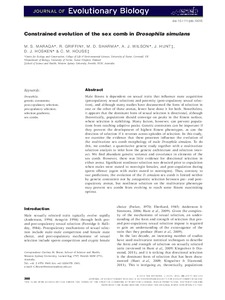Constrained evolution of the sex comb in Drosophila simulans
Maraqa MS; Griffin R; Sharma MD; Wilson AJ; Hunt J; Hosken DJ; House CM
Constrained evolution of the sex comb in Drosophila simulans
Maraqa MS
Griffin R
Sharma MD
Wilson AJ
Hunt J
Hosken DJ
House CM
WILEY
Julkaisun pysyvä osoite on:
https://urn.fi/URN:NBN:fi-fe2021042716767
https://urn.fi/URN:NBN:fi-fe2021042716767
Tiivistelmä
Male fitness is dependent on sexual traits that influence mate acquisition (precopulatory sexual selection) and paternity (post-copulatory sexual selection), and although many studies have documented the form of selection in one or the other of these arenas, fewer have done it for both. Nonetheless, it appears that the dominant form of sexual selection is directional, although theoretically, populations should converge on peaks in the fitness surface, where selection is stabilizing. Many factors, however, can prevent populations from reaching adaptive peaks. Genetic constraints can be important if they prevent the development of highest fitness phenotypes, as can the direction of selection if it reverses across episodes of selection. In this study, we examine the evidence that these processes influence the evolution of the multivariate sex comb morphology of male Drosophila simulans. To do this, we conduct a quantitative genetic study together with a multivariate selection analysis to infer how the genetic architecture and selection interact. We find abundant genetic variance and covariance in elements of the sex comb. However, there was little evidence for directional selection in either arena. Significant nonlinear selection was detected prior to copulation when males were mated to nonvirgin females, and post-copulation during sperm offence (again with males mated to nonvirgins). Thus, contrary to our predictions, the evolution of the D.simulans sex comb is limited neither by genetic constraints nor by antagonistic selection between pre- and post-copulatory arenas, but nonlinear selection on the multivariate phenotype may prevent sex combs from evolving to reach some fitness maximizing optima.
Kokoelmat
- Rinnakkaistallenteet [27094]
